Install the charging hoses of the gauge set to the fittings. Connect the low-pressure hose to the low-pressure service port, and the high-pressurehose to the high-pressure service port. Tighten the hose nuts by hand.
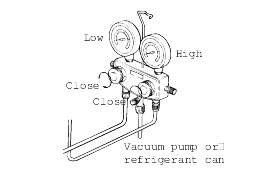
R-134a liquid refrigerant is highly volatile. A drop on the skin of your hand could result in localized frostbite. When handling the refrigerant,be sure to wear gloves.
It is standard practice to wear goggles or glasses to protect your eyes, and gloves to protect your hands. If the refrigerant splashes into youreyes, wash them with clean water immediately.
The R-134a container is highly pressurized. Never leave it in a hot place, and check that the storage temperature is below 52°C (126°F).
A electronic leak detector should be used to check the system for refrigerant leakage. Bear in mind that the R-134a, upon coming into contactwith flame, produces phosgene, a highly toxic gas.
Use only the recommended lubricant for R-134a systems. If lubricants other than the recommended one used, system failure may occur.
When removing refrigerant components from a vehicle, cap immediately the components to prevent from the entry of moisture.
When installing refrigerant components to a vehicle, do not remove the cap until just before connecting the components.
Complete the connection of all refrigerant tubes and hoses without delay to prevent the A/C system from taking on moisture.
Use the recommended lubricant from a sealed container only.
If an accidental discharge in the system occurs, ventilate the work area before resuming service.
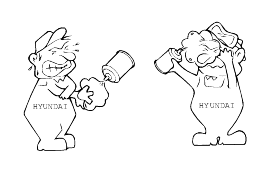
Never open or loosen a connection before discharging the system.
Seal the open fittings of components with a cap or plug immediately to prevent intrusion of moisture or dust.
Do not remove the sealing caps from a replacement component until it is ready to be installed.
Before connecting an open fitting, always install a new sealing ring. Coat the fitting and seal with refrigerant oil before making the connection.
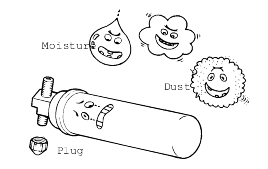
Check the new O-ring for damage (use only the specified) and lubricate it using compressor oil. Tighten the nut to specified torque.
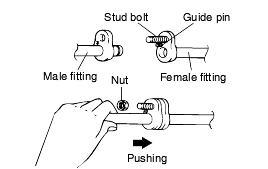
THE FOLLOWING PRECAUTIONS MUST BE OBSERVED
When it is necessary to open the refrigeration system, have everything you will need to service the system ready so the system will not be left openany longer than necessary.
Cap or plug all lines and fittings as soon as they are opened to prevent the entrance of dirt and moisture.
All lines and components in parts stock should be capped or sealed until they are ready to be used.
Never attempt to rebend formed lines to fit. Use the correct line for the installation you are servicing.
All tools, including the refrigerant dispensing manifold, the gauge set manifold and test hoses, should be kept clean and dry.
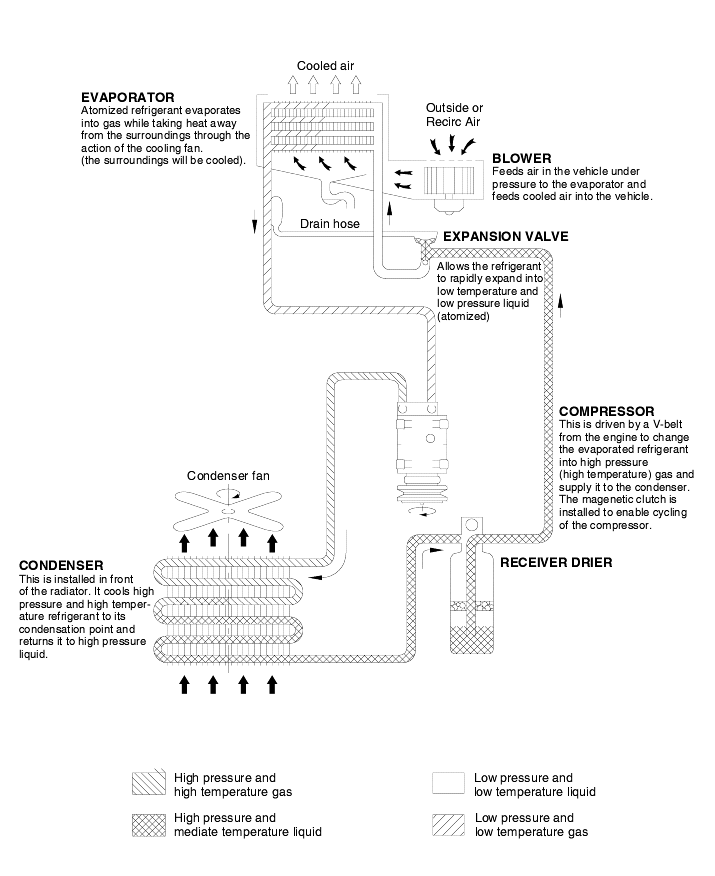
When connecting the manifold gauge set test hoses, be sure to observe all safety precautions.
Close both valves of the manifold gauge set.
Install the charging hoses of the gauge set to the fittings. Connect the low-pressure hose to the low-pressure service port, and the high-pressurehose to the high-pressure service port. Tighten the hose nuts by hand.

Connect the manifold gauge set to the system.
Put a towel under the open end of the center hose.
Open the high pressure valve slowly to discharge the refrigerant.
If discharging the refrigerant too fast, compressor oil may drain from the system.
Check if the towel is stained with oil. If so, gently close the valve.
If the manifold gauge reading drops below 3.5kg/cm², open the low pressure valve slowly.
Open the high and low pressure valves slowly in order to drop the system pressure until the gauge indicates 0kg/cm².
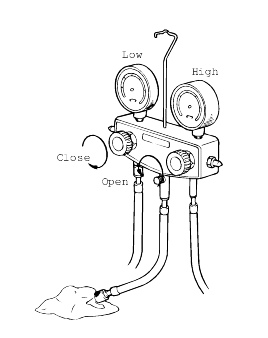
It is necessary to evacuate the air conditioning system any time the system has been opened. Evacuation is necessary to rid the system of all air and moisture that may have been allowed to enter the unit. After installation of a component, the system should be evacuated for approximately 15 minutes. A component in service that has been opened for repair should be evacuatedfor 30 minutes.
Engine should be off.
Connect a manifold gauge set to the compressor gauge fittings. Close both high and low pressure valves.
Make sure the refrigerant has been discharged from the system.
Connect the center hose of the gauge set to the vacuum pump inlet.
Start the vacuum pump and then open the high and low manifold pressure valves.
Close both manifold valves and stop the vacuum pump.
Charge the system with a can of refrigerant [about 0.4 kg (0.9 lb)]. Refer to Charging Refrigerant.
Check for refrigerant leakage with a leak detector. Repair any leakage found. Refer to Checking Refrigerant Leak.
Discharge refrigerant again, and then evacuate the system. If no leaks are found, continue evacuating the system.
Start the vacuum pump.

Open both manifold pressure valves to obtain 94.39 kPa (0.96 kg/cm², 13.7 psi) of vacuum.
After the low pressure manifold gauge indicates close to 94.39 kPa (0.96 kg/cm², 13.7 psi), continue evacuating for 15 minutes.
After evacuating for 15 minutes, close both manifold pressure valves and stop the vacuum pump. Disconnect the hose from the vacuum pump. The systemis now ready for charging.
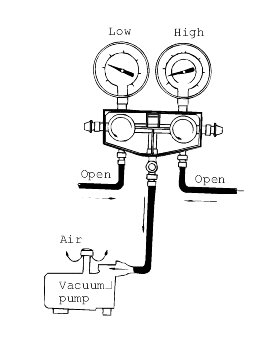
Before connecting the valve to the refrigerant container, turn the handle fully counterclockwise.
Turn the disc counterclockwise until it reaches its highest position.
Connect the center hose to the valve fitting. Turn the disc fully clockwise by hand.
Turn the handle clockwise to make a hole in the sealed top.
Turn the handle fully counterclockwise to fill the center hose with air. Do not open the high and low-pressure hand valves.
Loosen the center hose nut connected to the center fitting of the manifold gauge.
Allow air to escape for a few seconds, and then tighten the nut.
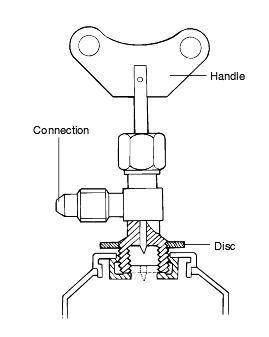
This step is to charge the system through the low pressure side with refrigerant in a vapor state. When the refrigerant container is placed rightside up, refrigerant will enter the system as a vapor.
Open the low pressure valve. Adjust the valve so that the low pressure gauge does not read over 412 kPa (4.2 kg/cm², 60 psi).
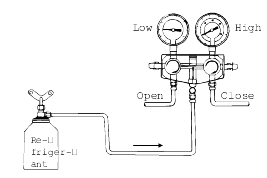
Put the refrigerant in a pan of warm water (maximum temperature 40°C or 104°F) to keep vapor pressure in the container slightly higher thanvapor pressure in the system.
Run the engine at fast idle and operate the air conditioning.
Be sure to keep the container upright to prevent liquid refrigerant from being charged into the system through the suction side, resulting inpossible damage to the compressor.
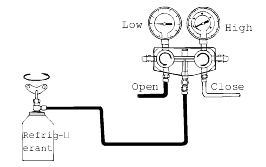
Charge the system to the specified amount. Then close the low pressure valve.
Specified amount : 600 ± 25g |
Under any circumstances the refrigerant must not be warmed in water heated to a temperature of over 52°C (126°F).
A blow torch or stove must never be used to warm up the can.

This step is to charge an empty system through the high pressure side with refrigerant in a liquid state. When the refrigerant container is heldupside down, refrigerant will enter the system as a liquid.
Never run the engine when charging the system through the high pressure side. Do not open the low pressure valve when the system is being chargedwith liquid refrigerant.
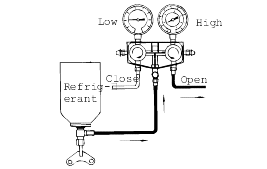
Close both high and low pressure valves completely after the system is evacuated.
Install the refrigerant can tap valve as described in "Handling Refrigerant Service Tap Valve" section.
Open the high pressure valve fully and keep the container upside down.
Charge the system to the specified amount by weighing the refrigerant with a scale. Overcharging will cause the discharge pressure (high side) torise. Then, close the high pressure valve.
Specified amount : 600 ± 25g |
If the low pressure gauge does not show a reading, the system is restricted and must be repaired.
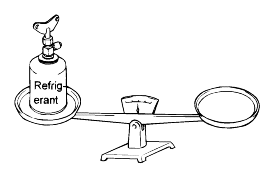
After the specified amount of refrigerant has been charged into system, close the manifold valve.
Confirm that there are no leaks in the system by checking with a leak detector. Refer to Checking Refrigerant Leak.
Conducting a performance test prior to removing the manifold gauge is good service operation.
Install the manifold gauge set.
Run the engine at 2,000 rpm and set the controls for maximum cooling and high blower speed.
Keep all windows and doors open.
Place a dry-bulb thermometer in the cool air outlet.
Place a wet-dry thermometer close to the inlet of the cooling unit.
Check that the reading on the high pressure gauge is 1,373-1,575 kPa (14-16 kg/cm², 199-228 psi). If the reading is too high, pour water onthe condenser. If the reading too low, cover the front of the condenser.
Check that the reading on the dry-bulb thermometer at the air inlet at 25-35°C (77-95°F).
Calculate the relative humidity from the psychrometric graph by comparing the wet-and dry-bulb reading at the air inlet.
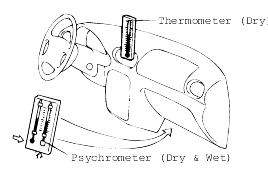
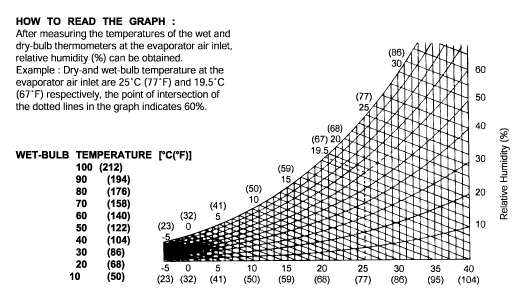
Measure the dry-bulb temperature at the cool air outlet, and calculate the difference between the inlet dry-bulb and outlet dry-bulb temperatures.
Check that the intersection of the relative humidity and temperature difference falls within the block below. If the intersection is within theblock, cooling performance is satisfactory.

The oil should be free from moisture, dust, metal filings, etc.
Do not mix oils.
The moisture content in the oil increases when exposed to the air for prolonged periods. After use, seal the container immediately.
Stop the engine, discharge the refrigerant, and dismantle the compressor from the vehicle.
Pour oil from the system line outlet.
If the compressor is cold, sometimes it can be hard to drain the oil. Warm the compressor (approx. 40-50°C) to drain the oil.
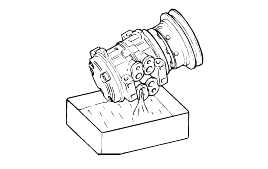
Check the volume of the discharged oil. If it is less than 70cc, it means there is little leak. Perform the leakage test on each system connection,and repair or replace faulty parts if necessary.
Check the oil for contamination and replenish the oil level in the following procedure:
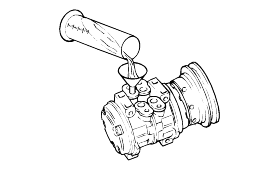
When oil is clean
Discharge | Setting |
Above 70cc | Oil level is normal. Add an equal amount of discharged oil. |
Below 70cc | Oil level is low. Add 70cc of oil. |
If the oil is contaminated with metal fragments or other material, clean the receiver drier after charging the refrigerant.
In order to use the leak detector properly, read the manual supplied by the manufacturer.
Check the torque on the connection fittings and, if too loose, tighten to the proper torque. Check for gas leakage with a leak detector.
If leakage continues even after the fitting has been tightened, discharge the refrigerant from the system, disconnect the fittings, and check theirseating faces for damage. Always replace, even if the damage is slight.
Check the compressor oil and add oil if required.
Charge the system and recheck for gas leaks. If no leaks are found, evacuate and charge the system again.
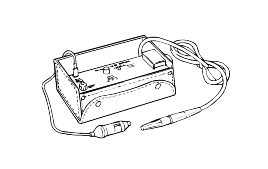
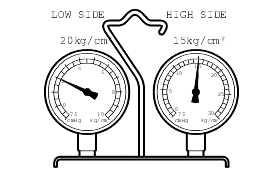
SYMPTOMS | PROBABLE CAUSES | REMEDY | MANIFOLD GAUGE READINGS |
1. Low pressure and high pressure are low. 2. Cooler outlet air is a little cooler. | ● Gas leak. | ● Check and repair. ● Add refrigerant. | 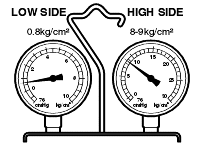 |
1. Low pressure and high pressure are high. | ● Faulty cooling or condenser freezing. ● Belt slip. | ● Maintain the proper level of refrigerant. Clean the condenser. ● Adjust the belt. | 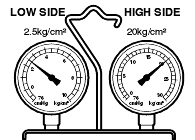 |
1. Low pressure and high pressure are high. 2. Low pressure pipe is not cold. | ● Air in the system. | ● Clean or repair the receiver drier. ● Check for oil contamination. | 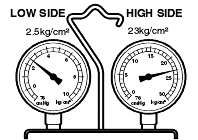 |
1. Low pressure side indicates negative pressure and high pressure side indicates low pressure. 2. Front or dew on pipes connected with receiver or expansion valve. | ● Dust or moisture frozen at expansion valve. ● Gas leak. | ● Repair the receiver drier and replace the expansion valve. ● Replace the expansion valve if the receiver-drier is faulty. |  |
1. Low pressure side pressure sometimes goes to negative pressure or normal. | ● Intaken moisture is frozen at expansion valve hole. | ● Repair and bleed receiver drier | 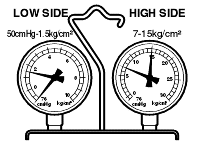 |
1. Low pressure and high pressure are high. 2. Much frost or dew on the low pressure side piping. | ● Expansion valve failure. Receiver-drier faulty. ● Flow control faulty. | ● Repair receiver drier. ● Check oil contamination. | 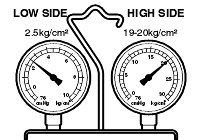 |
1. Low pressure side pressure is high and pressure side pressure is low. | ● Leak inside compressor. | ● Replace compressor. | 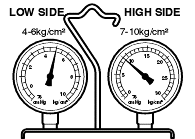 |